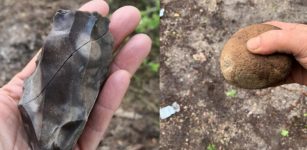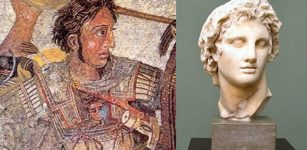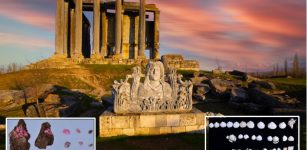Giant Azaes-Itzamna: Ninth King Of Atlantis, Founder Of Chichen Itza And Teacher Of Maya People
A. Sutherland - AncientPages.com - The Mayan pantheon comprises many gods. All of them stand below the greatest and most powerful of them – Hunab Ku, who is the supreme god and creator in the Maya pantheon.
He is “the god set over the gods”, invisible and beyond human understanding.
One of Hunab Ku’s son is Itzamna ("House of Lizard"), a name that corresponds to the Mayan mythological views of the Universe. The Maya believed that the earth rests on the back of a great lizard and that the cosmos was her home.
Plato's "Critias" may help us understand a very distant past and origin of great god Itzama.
Plato narrates that Poseidon fell in love with Cleito, the daughter to Evenor, the Atlantean, and had five pairs of sons who were twins.
One of the Atlantean twins was Azaes, known to the Maya as Itzamna. All the sons were given ten kingdoms and lived in peace with fabulous reaches of Atlantis. These Atlanteans built temples, palaces, harbors, canals and bridges and had access to rich forests, trees and minerals.
Later their descendants, “lived there for many generations, as sovereign of the sea and many islands, as has been spoken of vast territories and large people, from within, covering his kingdom is the land that extends to the Egypt and Tirrenia…”
Our earlier article was devoted to the Bacabs, the four giant sons of Itzama.
Now it is time to present Azaes/Itzamna himself, the ninth king of Atlantis listed in Plato's “Critias”.
As it was recorded in the chronicles, Itzamna arrived from the east with a group of the “Atlantean culture-bearers”. He founded the Maya city Chichen Itza and as the bringer of culture to his people, Itzamna became the national god of the Maya.
Itzamna possessed many different aspects. He was addressed as “Lord of the Night and the Heavens”, was responsible for rainfall, taught people to dig irrigation canals, and invented for them books and writing. His priests taught the use of herbs to treat people. His wife, Ix Chel was the goddess of medicine, childbirth and weaving.
See also:
Bacabs: Four Atlantean Gods Who Were Giants And Sons Of Itzámna, Maya God Of Heaven And The Sun
Ceiba Tree: Sacred Tree Of Life Of Maya People And Universal Concept In Ancient Beliefs
Kukulkan: Feathered Serpent And Mighty Mayan Snake God
Bolivia And The Mystery Of The Twins Of Atlantis
Itzamna was presented differently: as the dominant monarch, writer, old man with large square eyes and a hooked nose, and sometimes as a great celestial serpent. On the Maya ceremonial vessels, he was depicted as the king sitting on the throne before other gods.
Itzamna, seems to have been associated with the Maya sun god, Ahau Kin ("Lord of the Sun Face"). The images of the two deities have many similarities.
Often called Yaxkokahmut, ‘lord of knowledge’, he was identified with the sun-god, he was also lord of the east and the west.
Itzamna was the master of heaven, who, according to beliefs, "lived in clouds".
He appeared as an old man, whose body was decorated with the symbols of planets and the astronomical signs. At the same time, this god was considered a kind of two-headed dragon. It is worth mentioning that dragons roaming the sky were a frequent motif of myths and legends among ancient people of China, Babylonia, Tibet, India and ancient Egypt.
“Portrayed as a fair-skinned, bearded figure among the beardless natives, his title was “The First One.” He holds up the sky in the temple art of Yucatan’s foremost Maya ceremonial center, Chichen Itza, which was named after him and his descendants, the Itzas,” wrote Frank Joseph in “The Atlantis Encyclopedia”
“Chichen Itza is particularly noted for its Atlantean statuary and sculpted relief. Azaes-Itzamna was probably a real colonizer from Atlantis, who established his allied kingdom, which eventually took his name.”
Written by – A. Sutherland AncientPages.com Staff Writer
Copyright © AncientPages.com All rights reserved. This material may not be published, broadcast, rewritten or redistributed in whole or part without the express written permission of AncientPages.com
Expand for referencesReferences:
"History of the discovery and conquest of Yucatan" Juan Francisco Molina Solís.
Thompson J. E. S. The Bacabs: Their Portraits and Their Glyphs
Karl Taube, The Major Gods of Ancient Yucatan.
Eric S. Thompson. Historia y religión de los mayas
More From Ancient Pages
-
 Rare Stone Age Artifacts Found In Norway Offer Evidence Of Migration From The East
Archaeology | Aug 24, 2023
Rare Stone Age Artifacts Found In Norway Offer Evidence Of Migration From The East
Archaeology | Aug 24, 2023 -
 Tailteann Games: Ancient Irish Version Of The Olympic Games
Ancient History Facts | May 15, 2016
Tailteann Games: Ancient Irish Version Of The Olympic Games
Ancient History Facts | May 15, 2016 -
 Cupbearer Was Privy To Conversations And Political Secrets Hidden Behind Closed Doors
History | Feb 3, 2025
Cupbearer Was Privy To Conversations And Political Secrets Hidden Behind Closed Doors
History | Feb 3, 2025 -
 Cyclopean Fortress Of Sacsayhuamán – ‘Impossible’ Ancient Technology In Peru
Featured Stories | Apr 10, 2017
Cyclopean Fortress Of Sacsayhuamán – ‘Impossible’ Ancient Technology In Peru
Featured Stories | Apr 10, 2017 -
 Mysterious Yamacutah – A Sacred Native American Indian Shrine
Artifacts | Sep 18, 2020
Mysterious Yamacutah – A Sacred Native American Indian Shrine
Artifacts | Sep 18, 2020 -
 Why Didn’t Alexander The Great’s Body Show Signs Of Decomposition For Several Days? A Never-Before Suggested Explanation – From Scientists
Archaeology | Jan 24, 2019
Why Didn’t Alexander The Great’s Body Show Signs Of Decomposition For Several Days? A Never-Before Suggested Explanation – From Scientists
Archaeology | Jan 24, 2019 -
 Ancient Fossils Reveal Climate Altered Humans’ Body And Brain Size
Archaeology | Jul 8, 2021
Ancient Fossils Reveal Climate Altered Humans’ Body And Brain Size
Archaeology | Jul 8, 2021 -
 First 5th Century Mosaic Found Near Cirencester Once The Second-Largest Roman-British Town In England
Archaeology | Dec 16, 2020
First 5th Century Mosaic Found Near Cirencester Once The Second-Largest Roman-British Town In England
Archaeology | Dec 16, 2020 -
 On This Day In History: Berlin Opened For One Day – On Dec 20, 1963
News | Dec 20, 2016
On This Day In History: Berlin Opened For One Day – On Dec 20, 1963
News | Dec 20, 2016 -
 Roman Cosmetics Shop Discovered In The Ancient City Of Aizanoi, Turkey
Archaeology | Sep 29, 2023
Roman Cosmetics Shop Discovered In The Ancient City Of Aizanoi, Turkey
Archaeology | Sep 29, 2023 -
 4th-Century Roman Coin And Pub-Like Structure With Heating System Excavated In Slovakia
Archaeology | Aug 11, 2020
4th-Century Roman Coin And Pub-Like Structure With Heating System Excavated In Slovakia
Archaeology | Aug 11, 2020 -
 Castor And Pollux: Dioscuri Brothers Immortalized In The Night Sky In Greek Beliefs
Featured Stories | Jan 24, 2024
Castor And Pollux: Dioscuri Brothers Immortalized In The Night Sky In Greek Beliefs
Featured Stories | Jan 24, 2024 -
 On This Day In History: ‘Sea King’ Ragnar Lodbrok Seizes Paris – On March 28, 845
News | Mar 28, 2017
On This Day In History: ‘Sea King’ Ragnar Lodbrok Seizes Paris – On March 28, 845
News | Mar 28, 2017 -
 Mystery Of The Ancient Reptilian Gods Remains A Complex Subject – Alien Worlds – Part 2
Ancient Mysteries | Feb 9, 2022
Mystery Of The Ancient Reptilian Gods Remains A Complex Subject – Alien Worlds – Part 2
Ancient Mysteries | Feb 9, 2022 -
 Surtshellir Cave Reveals How Vikings Attempted To Prevent Ragnarök – Doom Of The Gods
Vikings | Jul 17, 2023
Surtshellir Cave Reveals How Vikings Attempted To Prevent Ragnarök – Doom Of The Gods
Vikings | Jul 17, 2023 -
 Unclear Purpose Of Mysterious Rock-Cut City Of Petra – Was It A Fortress Or Sacred City?
Featured Stories | May 30, 2020
Unclear Purpose Of Mysterious Rock-Cut City Of Petra – Was It A Fortress Or Sacred City?
Featured Stories | May 30, 2020 -
 1,500-Year-Old Fingerprints Will Say Much About Potters And Communities That Once Lived In Motza
Archaeology | Nov 10, 2022
1,500-Year-Old Fingerprints Will Say Much About Potters And Communities That Once Lived In Motza
Archaeology | Nov 10, 2022 -
 Unique Viking Age Arm Ring Found On Öland And Stunning 2,000-Year-Old Gold Torc Discovered In Trollhättan, Sweden
Archaeology | Mar 19, 2025
Unique Viking Age Arm Ring Found On Öland And Stunning 2,000-Year-Old Gold Torc Discovered In Trollhättan, Sweden
Archaeology | Mar 19, 2025 -
 Golden Figurine From Yozgat Depicts Unknown Hittite God
Artifacts | May 11, 2016
Golden Figurine From Yozgat Depicts Unknown Hittite God
Artifacts | May 11, 2016 -
 Spearhead Mound – Destroyed Burial Place Of Adena Giants?
Featured Stories | Jun 1, 2021
Spearhead Mound – Destroyed Burial Place Of Adena Giants?
Featured Stories | Jun 1, 2021



